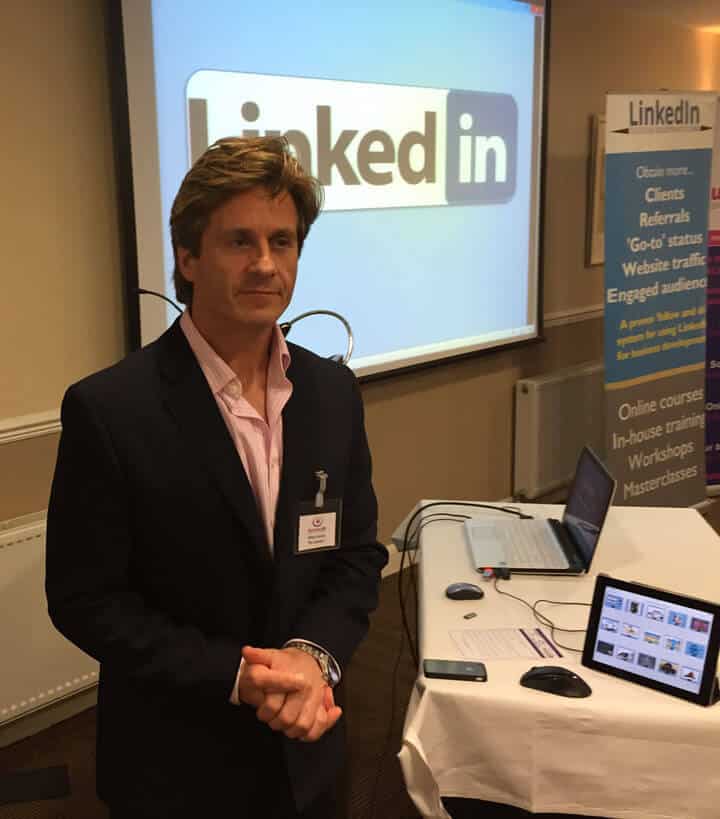
I attended the Business 50 Interactive event on Tuesday, which is always an enjoyable event with speed networking, exhibitors, talks and prizes. I was pleased to scoop the Cash for Chat prize for the second year running!
I heard Miles Duncan give an engaging and practical presentation on using LinkedIn effectively. Miles is known as ‘Mr LinkedIn’ and has built a reputation as an authority on the subject.

Why use LinkedIn?
LinkedIn is not like other social networks; it’s more serious and business focused. Half the UK workforce are on LinkedIn, so it’s really important to have a good profile. Potential new clients or employers are very likely to look you up on LinkedIn, and a badly done or incomplete profile could let you down.
I can say that personally, after updating my LinkedIn profile one time and adding WordPress to my headline, I got contacted about a good WordPress job the very next day and got the work. So it’s definitely worth investing some time in.
One tip before you start tinkering – make sure that you have the ‘Notify your network’ setting set to No. It’s on the right hand side of the Edit Profile screen (you may have to scroll to see it).
I also recommend using the desktop version of LinkedIn to make your changes.
5 key areas of your LinkedIn profile to get right
1. Headline
This should not be your job title! You need to include keywords which relate to your work, or the type of people you work with. Think of what recruiters or clients would be searching for.
You have a maximum of 130 characters to play with, so make them count. (I could add a bit more to mine.) Put the most important stuff at the beginning.
2. Summary
Your summary can be up to 2,000 characters – try to use them all.
You should include:
- Some words to show you understand your target audience.
- A statement of the problems you solve and how you fix them.
- The benefits of working with you.
- Contact information.
- Let people know what to do next if they want to work with you.
- Some examples of media you’ve worked on – this could be documents, video, audio or presentations.
3. Experience
List your work experience, putting the most focus into what you currently do.
Point out your successes, include any testimonials and include a call to action.
4. Skills
Here you should list at least 10 key skills, and get 10 or more endorsements for each one.
If you have a couple of similar competencies and one is endorsed more than the other, delete the less popular one and ask your connections to re-endorse you for the other. As you can see below, I could do this for HTML5 and HTML.
Don’t take this section too seriously, as it’s possible to be recommended by people you’ve never met.
5. Additional info
List your interests – don’t forget those keywords again.
You can also add advice for contacting you – put in appropriate contact details here.
Other profile sections to give attention
- You need to have a well-chosen professional headshot as your photo. Here are some examples of bad LinkedIn profile pictures – don’t make the same mistakes as these people!
- It also helps to have an appropriate LinkedIn header image; bonus points if you include a call to action. The image needs to be 1400 x 425 px in size. I still have to do this.
- Claim your personal URL for LinkedIn if you can.
- Recommendations – ask folk to be recommended for something specific, and remember to recommend others yourself.
- Join groups. Not just ones for your industry, but ones where you can find clients. You can be a member of up to 50 groups.
After you have improved your LinkedIn personal profile

Interestingly, in Miles’ opinion, only after you have optimized your profile are you ready to start connecting with people!
Once you have made connections, the key is to create a sales funnel and work on building relationships with your contacts.
You can find out more on Miles’ training course, the LinkedIn Success Blueprint.
Sometimes it’s hard to be objective when we write about ourselves. David Petherick of Amazes.me helps people improve their LinkedIn profiles, and offers free tips on his website.
I hope these tips help you score some quick wins on LinkedIn.
Feel free to check out my LinkedIn profile, connect and let me know what I could improve on!





Interesting post. I do use LinkedIn, but it tends to be an afterthought at the moment. Maybe something I will dedicate a bit more time to. Thanks
Thanks Wendy – you’re rapidly becoming my “top commenter”!
Time for us to link in, perhaps?
Hi Just a query – I thought the LinkedIn summary was 2000 CHARACTERS (at one time it was 2400) that’s way shorter than 2000 words. Has it changed again?
Dorothy, you’re absolutely right – my mistake. Have updated the article. Thanks for reading.
I’ve started reposting some old blog content on LinkedIn. I find it to be a really valuable marketing tool, and that many of my old colleagues are willing to help me build my business that I contact on there.
Thanks for commenting, Sharon.
I’ve wondered how straightforward it is to publish posts on LinkedIn. I seem to remember reading that you should wait a few weeks before adding blog content on LI so Google recognizes that your blog is the original source.
Has that been what you’ve done?